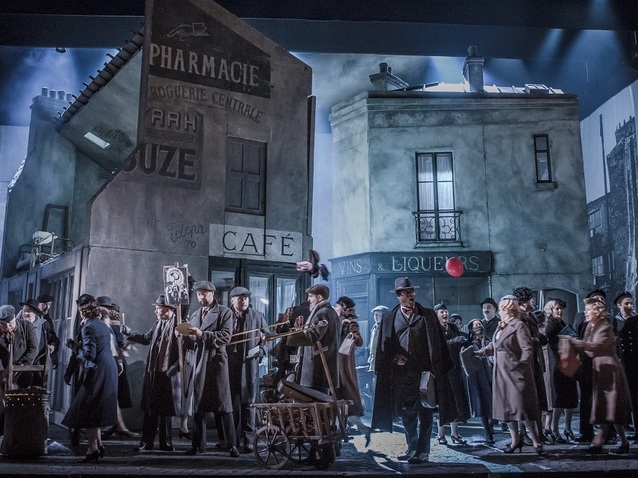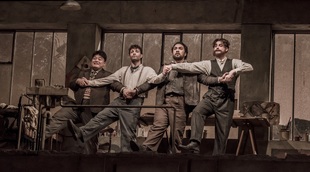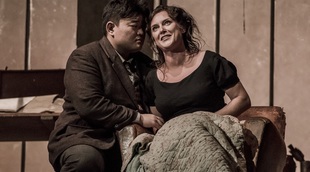 ENO La bohème 2022, company © Genevieve Girling
ENO La bohème 2022, company © Genevieve Girling
Giacomo Puccini’s 1896 creation La bohème is one of the most frequently performed operas in the world today. Set in 1830s Paris, it focuses on six young adults and the love that four of them find with each other amidst the most impoverished of circumstances. One couple, Marcello and Musetta, have a stormy relationship but their frequent battles prove that their love actually has staying power. Rodolfo and Mimì, on the other hand, enjoy an apparently perfect love, but it is only fleeting as poverty offers no relief to Mimì and she dies of consumption.
Jonathan Miller’s production for English National Opera has had quite a colourful history. Its first performance ever, scheduled for 2 February 2009, was ironically cancelled due to snow, and when it finally appeared its reception was rather mixed. It grew stronger, however, with each of its first three revivals (in 2010, 2013 and 2014) so that it soon established itself as one of the mainstays of ENO’s repertoire. A new version of the opera from Benedict Andrews appeared in 2015, but was not well received, which prompted the return in 2018 of what is now generally acknowledged to be a classic production. This 2022 outing, with Crispin Lord as the revival director, constitutes its first appearance since both Miller and Amanda Holden, who was responsible for its English translation, sadly died in 2019 and 2021 respectively.
Miller moves the action from its original 1830s setting to depression soaked Paris a century later, and this helps to make the drama feel highly relevant to us today. Many productions allow us to relate to the concepts of poverty and love, while still making the characters feel as if they exist largely in another time and place. Here, in contrast, we associate with the people themselves, thanks to the attention to detail paid both to the characterisations and the setting that the individuals inhabit.
In Isabella Bywater’s generally effective set, Rodolfo and Marcello’s garret can actually be seen within a larger set of buildings, so that the first and last acts take place on a level high above the stage. The characters also use a staircase to leave the garret, rather than simply disappearing from view when they pass through the front door, which adds further context to their situation. For example, when Schaunard leaves Rodolfo and Mimì alone together in Act IV he does not exit the stage as normal, but collapses in an inconsolable heap on the steps outside, thus introducing a further dimension by revealing his total inability to cope with the unfolding tragedy. Similarly, when the four principal men boot the landlord Benoît out without the rent, we witness one of many slick comic moments that could not have come to fruition on a more conventional set. With the threat of his infidelities being revealed to his wife, we actually see him tumbling down the stairs as he is thrown out before the men form an angelic chorus to send him scurrying on his way.
Puccini intended the final notes of the Act I duet ‘O soave fanciulla’ to be sung offstage so that they drifted through to the audience, and this production ensures that they do, even though Rodolfo and Mimì have to travel further to exit as their descent from the garret can still be seen. However, the flexibility of the set enables Rodolfo to begin his encounter with Mimì at the bottom of the stairs, which her illness means she has difficulty in climbing, when she returns to the garret in Act IV, which would not be possible if these could not be seen.
When the set spins around to reveal Café Momus in Act II, we are confronted with a Christmas card scene of people selling their wares and playing in the snow. All of the figures in the crowd stand out as individuals as they include lesbians lovers and transgender people, while in Café Momus the seven main protagonists are essentially sat in a line in an order that enables the necessary interactions to play out, only without it ever feeling as if they are simply in a rigid row. Even here, however, the setting is never overly romanticised since the visuals equally recall the grittier images of Brassaï and Cartier-Bresson. In this way, large photographs of Parisian ‘slums’ surround the stage as a stark reminder of what poverty really means.
Several roles are double cast over the current run, so that Nadine Benjamin plays Mimì, Alex Otterburn sings Schaunard and Elin Pritchard takes on Musetta for some performances. On the occasion I attended David Junghoon Kim was feeling under the weather and so acted the role of Rodolfo while Adam Gilbert sang the part from the side with a score. No one is to blame for this, and the scenario may never be repeated during the run, but it is difficult for the same perfect blend to be achieved between Rodolfo and Mimì in their various duets, and between Rodolfo and Marcello in ‘O Mimì, tu più non torni’, when the sounds are coming from very different points. Similarly, Kim mouthed some of his words to a greater extent than others, with the consequence that he did not seem to be inside the part to the same degree throughout, which also did not aid his rapport with Mimì. However, this could not be helped as it is impossible to shape the mouth exactly as it would be if sound were coming out across an entire performance, and it was still clear that Kim is a very engaging actor to whom we wish a speedy recovery.

ENO La bohème 2022, David Junghoon Kim, Charles Rice, Benson Wilson, William Thomas © Genevieve Girling

ENO La bohème 2022, David Junghoon Kim, Sinéad Campbell-Wallace © Genevieve Girling
Gilbert sang tremendously well with his full and expansive tenor really coming to the fore, and if his climax to ‘Che gelida manina’ was good rather than exceptional, it was remarkable what he achieved when preparation time was clearly limited. One could hear him softening his sound at the end of ‘Addio dolce svegliare alla mattina!’ to ensure it did not overwhelm Mimì’s as she was positioned much further down the stage, and it would be good if he could play Rodolfo in full himself one day.
Sinéad Campbell-Wallace as Mimì displays a full, sumptuous but appropriately sensitive sound and puts the right levels of sweetness and confidence into the character. Rodolfo dangles her supposedly lost key in front of her after they have agreed to go out, but she is not fazed by this as she was never fooled in the first place. Charles Rice and Louise Alder give excellent portrayals of Marcello and Musetta, being blustery or feisty when necessary but also displaying a greater degree of vulnerability than we often see. As they hurl insults during ‘Addio dolce svegliare alla mattina!’ there is suddenly one that cuts so deep that the two are left gazing enviously on the relationship that Rodolfo and Mimì enjoy before parting feeling genuinely hurt.
William Thomas and Benson Wilson demonstrate strong voices as Colline and Schaunard respectively and form something of a ‘double act’ as they march off as a pair with the military tattoo at the end of Act II in the same way as Rodolfo and Mimì and Marcello and Musetta do. However, if all this looks like they are jesting, their dancing and duelling in Act IV suggest that Colline would like there to be something between them but that Schaunard does not reciprocate his feelings. Simon Butteriss delivers two splendid cameo performances as Benoît and Alcindoro, even interjecting many spoken lines that are not in the original. Although there are a few too many of these during ‘Quando me’n vo’, when really we want to focus on the aria, overall they work very well. Conductor Ben Glassberg delivers a clear, bright account of the score ensuring that balance and detail are paramount while still doing full justice to its sweeping nature.
By Sam Smith
La bohème | 31 January – 27 February 2022 | London Coliseum
the 07 of February, 2022 | Print

Comments